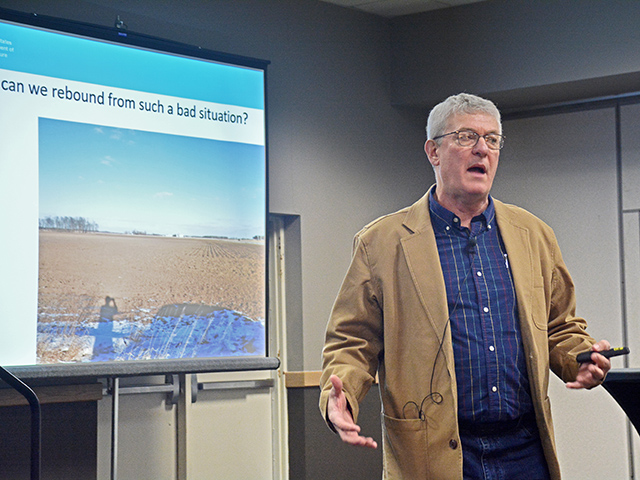Resilient Soil
Cover Crops - Resilient Soil
Cover crops should be the go-to play for row-crop farmers to provide a stable, growing food supply for years to come, a federal conservation expert explains.
Barry Fisher, a U.S. Department of Agriculture Natural Resources Conservation Service soil health specialist, based in Indianapolis, believes farmers need a game plan to manage weather extremes. Adopting or increasing cover-crop use to protect the land from erosion and build soil health is the winning call.
"If this extreme weather continues to be a trend, we need game-time management decisions," Fisher told farmers and ag researchers at the February Midwest Cover Crops Council Annual Conference, in Kansas City, Missouri. "That's why we're here talking about cover crops. Soil needs to continue to function under extreme conditions, whether too much or not enough water."
Erratic and severe-weather events are on the rise. The U.S. experienced its wettest 12-month period from May 2018 to April 2019, which culminated in epic flooding along the Mississippi and Missouri rivers, and a record 19.4 million acres that didn't get planted nationwide. Since 1901, the average surface temperature across the contiguous 48 states has risen at an average rate of .14°F per decade. Eight of the top 10 warmest years on record have occurred since 1998.
Drought negatively affects farmers in various parts of the country every year, but more than 60% of the nation was affected in the summer of 2012. Iowa experienced its worst widespread drought in more than seven years in the latter half of the 2020 growing season.
"We got started into cover crops ... to stay in business," says Shawn Tiffany, a cattle and grain farmer from Herington, Kansas. "We have to quit letting our most precious resource leave our fields."
P[L1] D[0x0] M[300x250] OOP[F] ADUNIT[] T[]
Planting cereal rye, annual rye, oats, hairy vetch and a host of other cover crops just before or after harvest makes soil resilient to counter Mother Nature's extremes, Fisher says. Living roots year-round have many benefits besides keeping precious topsoil in fields.
Here are just a few benefits:
> nutrient cycling/nitrogen scavenging
> aggregate stability
> water infiltration and availability
> microbial activity
> weed suppression from decomposing biomass.
"These core principles should be in the back of your mind when you put together a (agronomic) game plan," Fisher told farmers and agronomists at the conference. "You need to protect soil from heat, wind, rain and other destructive forces."
Fisher understands paying $37 per acre to buy and seed cover crops -- the median cost, according to a recent Sustainable Agriculture Research and Education (SARE) technical bulletin -- can be cost-prohibitive to many producers when commodity prices are low. However, he contends the conservation practice is a long-term investment that will pay.
Cover crops net $1.42 per acre after three years of use in fertilizer, weed-control and erosion-repair savings, as well as yield increases, according to SARE research.
"There's broadly accepted indicators and functions that drive improved production, resilience to extreme growing conditions and reduced costs that lead to net economic gain," Fisher says.
> Follow Matthew Wilde on Twitter @progressivwilde.
FOR MORE INFORMATION
> Sustainable Agriculture Research and Education Technical Bulletin: www.sare.org
> Midwest Cover Crops Council: mccc.msu.edu
[PF_1020]
(c) Copyright 2020 DTN, LLC. All rights reserved.






